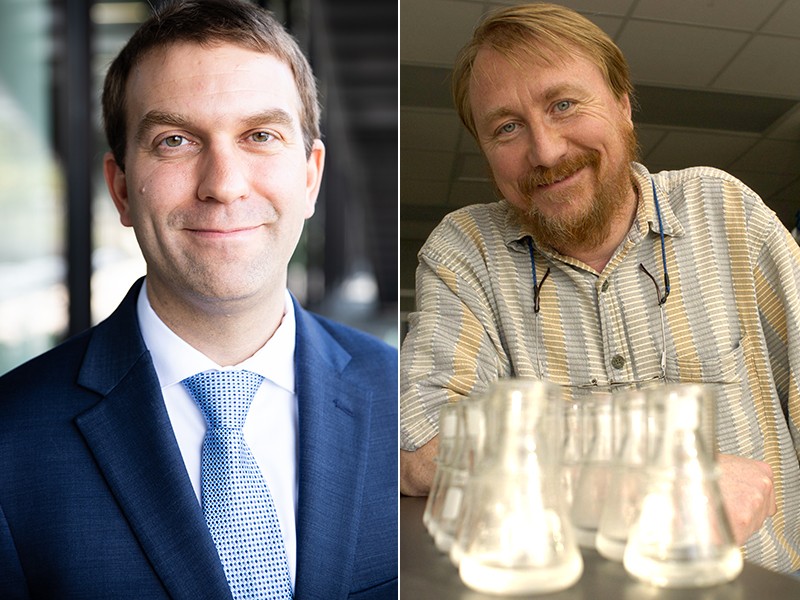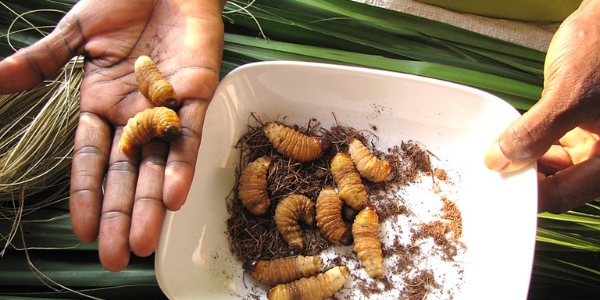Legendary bacterial evolution experiment enters new era
On Feb. 24, 1988, evolutionary biologist and EEB former director Richard Lenski filled 12 flasks with sugary growth medium and seeded each with Escherichia coli bacteria. For the past 34 years, Lenski, at Michigan State University in East Lansing, and his colleagues have nurtured the bacterial cultures, refreshing growth media daily and freezing samples for future study every couple months.
The long-term evolution experiment (LTEE) has become a cornerstone in evolutionary biology that researchers continue to mine for insights. During their 75,000 generations of growth, the bacteria have made huge gains in their fitness — how fast they grow relative to other bacteria — and evolved some surprising traits.

Last month, Lenski, Hannah Distinguished Professor of Microbial Ecology in the College of Natural Science and his lab tended to the LTEE for the last time. The 12 E. coli lines are now frozen in cryoprotective media and will soon be revived to begin a new life in the laboratory of Jeffrey Barrick, an evolutionary biologist at the University of Texas at Austin who first worked on the experiment in the 2000s as a postdoc in Lenski’s lab.
The two spoke to Nature about the past, present and future of one of biology’s longest-running experiments.
What inspired you to begin the experiment?
Richard Lenski: I like big open-ended questions. I wanted a very simple, long experiment to look at how repeatable evolution was. The original goal was 2000 generations. And I figured that deserves the moniker ‘the long-term evolution experiment’. I had no idea that it would go as long as it has actually gone — and hopefully will go much longer.
Why did you keep it going — and going and going?
Lenski: It’s actually a very easy experiment to maintain. The amount of work for an individual on a typical day is maybe half an hour. It is 365 days a year, at least in principle, but the amount of work per day isn’t huge.
And then, of course, the bacteria were doing very interesting things over time. New technologies emerged, like the ability to sequence genomes cheaply. People like Jeff joined the lab and brought new ideas and questions. And the bacteria kept doing interesting things. I realized that it should just go on for as long as humanly possible.
How many generations had passed when Jeff started working on the experiment?
Lenski: Did you join the lab in about 2007? It was probably around 40,000 generations.
Jeffrey Barrick: Sounds about right. I knew less going in about the history of the experiment — maybe less than a lot of Rich’s postdocs and graduate students. But I was at a time in my career where I had been studying evolution at the molecular level, looking at all kinds of bacterial genomes. I wanted to study evolution of whole organisms in the lab and be able to watch evolution. It's just been something I've been fascinated by ever since I was an undergraduate.
Was it ever a challenge to keep the experiment going?
Barrick: Like Rich said, it's fairly simple. There are some major snowstorms and other things that go on, and other infrastructure anomalies that can make it sometimes challenging, but you can always go back to the freezer, which is one really nice thing about the experiment and makes it much more doable than other experiments. People have tried long-term experiments with mice and flies and other organisms where it's really difficult if something goes wrong.
Lenski: One of the advantages of the long-term experiment is everything is so simple. We work with a chemically defined medium, we can freeze strains and revive them so that knock on wood, I think it should continue quite smoothly in the new home.
What has the experiment taught us about the repeatability of evolution?
Lenski: My bias going into the experiment was that all the strains would go off in very different directions. I was thinking that the roles of chance and contingency in evolution would have been larger than they were. And over the years, we’ve actually seen just striking amounts of reproducibility. So although a typical line has improved its relative fitness compared with the ancestor by maybe 70% or 80%, the variance in competitive fitness between most lines is more like just a few per cent. So they’ve all tremendously increased, but very similarly to one another.
But then, over the years we've also seen quite striking divergences between the lines. Thirty thousand generations into the experiment one of the 12 lines evolved the ability to consume citrate, instead of just glucose. And that garnered quite a lot of attention, and even some, shall we say, hostility from some people who are sceptical of the power of evolution. And after 75,000 generations , it’s still the only one of the 12 lines that has evolved that ability.
Are there big questions about evolution that you hope to answer by going longer?
Barrick: For a lot of bacteria that ended up in simple, constant environments — especially simple endosymbionts that live inside the cells of insects — their genomes gradually shrink over time. And I’d say one of the more surprising things to me is that these E. coli have been in a very constant environment, yet their genomes have not shrunk very much.
Lenski: I think part of the issue on the genome shrinkage is that that's a slow process. Thirty years and 75,000 generations — it's a drop in the evolutionary bucket. So I would guess that if we could come back — in one million years or whatever, the bacteria probably would have extremely reduced genomes. That’s a reason to keep it going.
Why did you decide to pass the torch on the LTEE?
Lenski: I'm not going to be around forever. I think it’s better to do those things now, to plan them carefully and thoughtfully. So it just made sense. I’m 65 years old , and although I don't plan to retire any time in the next few years at least, the lab is getting smaller. And one of the important things for keeping the long-term lines going is this daily rhythm. I think a lab that has half a dozen or more people is ideally suited to the weekend and holiday coverage that the experiment benefits from.
So I asked Jeff, maybe in 2018 or 2019. I have a National Science Foundation grant to run the experiment, and Jeff is now a co-principal investigator on that. And when we wrote the most recent renewal, we laid out this plan for the transfer and that it would take place around now.
Read the full interview in Nature



